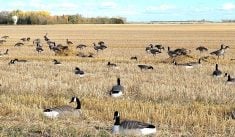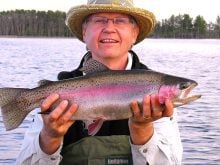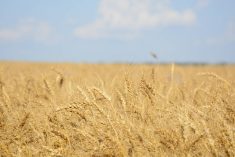Snow wasn’t the only white creeping across Manitoba’s fields this spring, and unlike snow, this white stuff won’t be melting away.
High salinity is not a surprising topic for provincial soil specialist Marla Riekman, given the province’s still-dry conditions and the rise in salinity questions she’s fielded from producers in the last few years.
Salinity is, as she has commonly said during her presentations and webinars, a water problem. Patches prone to the issue — like low areas — chronically ebb and flow, depending on the level on the water table at the time. In wet years, the high water table and precipitation keep salts washed down. Salinity seems to disappear. When the taps turn off however, it’s another matter altogether.
Read Also

YEAR IN REVIEW: 2025 a year of weather extremes
Wildfires, drought and flash floods, oh my! Looking back at the year’s headline-grabbing events in Canada and around the world.
“My level of concern on salinity doesn’t go away even when the salinity goes away, because I know that it’s always a temporary kind of disappearance,” she said. “It’s always coming back.”
2021 is shaping up to be another dry season, and the lowered water table, with no precipitation to wash down salts, is starting to show.
By all indications, this year is going to be one for salinity to be in full display.
April rain and snowfalls gave a much-needed shot of moisture to most of the province earlier this month, but most of southern Manitoba had still seen less than 30 per cent of normal precipitation since November, as of the third week of April. Except for patches in the Parkland, east and north Interlake, all of agro-Manitoba still sat below 60 per cent of normal winter and spring precipitation, the province’s ag weather network reports.
Prior to that, 2020 had also been generally dry. Save for a wet fall in 2019 — punctuated by a snowstorm over the Thanksgiving weekend — the year before that had been dry as well, as was the year before that.
“Without additional moisture allowing some of those salts to move back down again, they’re going to continue to wick up because there’s higher upward movement, or evaporation from the surface right now than there is actually rainfall pushing the salts back down again,” Riekman said.
It will take more than one rainfall or snowstorm to wash those salts back down, she added.
Tile, forage and changing it up
Producers may want to immediately rethink their plans for those saline patches, Riekman said.
It makes little economic sense to waste inputs on areas that are unlikely to yield, she said, while tilling those areas only serves to make the problem worse, as disturbing that soil encourages yet more evaporation.
Tile drainage, something she gets asked about frequently, can help in some cases, Riekman said, assuming the field is already a good candidate.
“First of all, your soil needs to be appropriate for tiling,” she said. “You need to have a place for that water to flow and you actually need to have land that has that high water table that is going to be lowered by the installation of tile.”
But just as one rainfall event will not automatically fix salinity issues, installing tile drainage is not a silver bullet, she added.
“The salts still have to be moved physically down the soil profile and out that tile line, so that can be very dependent on how much precipitation actually happens after the tile has been installed. So you can install tile, but you might not see the salinity go away for many, many years if you’re in a dry season.”
Others might opt for seeding patches down to saline-tolerant forage — something that will compete with weeds while potentially recapturing some value through hay.
Lyle Cowell, agronomic services manager with Nutrien Ag Solutions, says the company has seen more interest for products like AC Saltlander wheatgrass and Halo alfalfa, as well as blends that incorporate saline-tolerant forage.
“People are realizing that some farmland is simply incapable of supporting annual crops and you’re better off actually having a forage there than having nothing,” he said. “It’s a slow adaptation, because it’s not easy to seed three or four acres here and there of a forage species with the size of equipment that most guys have on a farm.”
At the same time, Riekman also cautioned that the already challenging prospect of establishing forage on saline soil becomes even more of an issue in a dry year, like 2021 is shaping up to be.
Some producers have found success using shredded bales as soil cover to help establishment, Riekman said.
“Essentially, it helps protect future evaporation, so it’s keeping some of that moisture inside the soil and it’s actually helping the seedlings get going.”
Work through the University of Saskatchewan has explored establishment practices on saline-tolerant forage, while Cowell noted that Nutrien Ag Solutions is also launching variety trials, including trials planted at the Ag in Motion site near Langham, Sask., last year.
A producer’s willingness to tackle patch management often depends on where that patch is in the field, Riekman said.
Producers may be unwilling to create an obstacle for themselves by seeding a forage patch in the middle of a field, compared to strips at the field edge or an existing slough, she noted.
“That is an easier thing to adapt to,” she said.
“There is resistance, and it’s understandable resistance because of the fact that managing a patch in the middle of the field differently to the rest of the field can be problematic,” she said. “But, that being said, there have been more people who have been reaching out to me talking about alternative ways to manage those pieces of land.”

A fight on two fronts
It’s hard to talk about salinity without also talking weeds.
Salinity is a friend to some of Manitoba’s major weeds such as foxtail barley or kochia, which grow readily in salinity levels that stymie annual crops.
Despite the often-flourishing weed problems, Riekman noted, getting rid of those weeds without thought to salinity management might actually be the start of a vicious cycle.
“If you’re tilling to kill the weeds, you’re going to eventually make the problem worse because you’re causing more of that salinity to arise,” she said.
Instead, she suggested, a producer might be better off using one problem to fight the other.
Riekman commonly advises producers to consider managing saline weed patches through mowing. Weeds are kept vegetative, and therefore still controlled, but the method keeps plants growing, using up water and drawing down salinity — in some cases, the only plants that will grow.
“You don’t want it to set seed, but you want it to grow, so you actually allow the weeds to work for you in that case,” she said, adding that those same weeds can actually have decent feed value once mowed and baled. “There’s some management obviously involved in it, but it’s less than having to go out and invest money into that patch by seeding it down.”
















